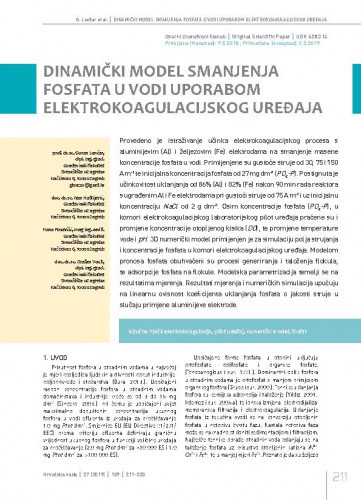Provedeno je istraživanje učinka elektrokoagulacijskog procesa s aluminijevim (Al) i željezovim (Fe) elektrodama na smanjenje masene koncentracije fosfata u vodi. Primijenjene su gustoće struje od 30, 75 i 150 A m-2 te inicijalna koncentracija fosfata od 27 mg dm-3 (PO4-P). Postignuta je učinkovitost uklanjanja od 86% (Al) i 82% (Fe) nakon 90 min rada reaktora s ugrađenim Al i Fe elektrodama pri gustoći struje od 75 A m-2 i uz inicijalnu koncentraciju NaCl od 2 g dm-3. Osim koncentracije fosfata (PO4-P), u komori elektrokoagulacijskog laboratorijskog pilot uređaja praćene su i promjene koncentracije otopljenog kisika (DO), te promjene temperature vode i pH. 3D numerički model primijenjen je za simulaciju polja strujanja i koncentracije fosfata u komori elektrokoagulacijskog uređaja. Modelom pronosa fosfata obuhvaćeni su procesi generiranja i taloženja flokula, te adsorpcije fosfata na flokule. Modelska parametrizacija temelji se na rezultatima mjerenja. Rezultati mjerenja i numeričkih simulacija upućuju na linearnu ovisnost koeficijenta uklanjanja fosfata o jakosti struje u slučaju primjene aluminijeve elektrode..; An investigation was carried out into the impact of the electrocoagulation process with aluminium (Al) and iron (Fe) electrodes on the reduction of mass concentration of phosphate in water. The current densities of 30, 75 and 150 A m-2 and the initial phosphate concentration of 27 mg dm-3 (PO4-P) were applied. The removal efficiency of 86% (Al) and 82% (Fe) was achieved after a 90-minute operation of the reactor with installed Al and Fe electrodes at the current density of 75 A m-2 and initial NaCl concentration of 2 g dm-3. In addition to phosphate (PO4-P) concentration, changes in the concentrations of dissolved oxygen (DO), water temperature and pH were also monitored in the chamber of the electrocoagulation laboratory pilot device. A 3D numerical model was implemented for simulation of the electric field and phosphate concentration in the chamber of the electrocoagulation device. The model of phosphate transfer included the processes of generation and sedimentation of floccules and the adsorption of phosphate on the floccules. The model parametrization is based on the measurement results. The results of measurements and numerical simulations indicate a linear dependency of the phosphate removal coefficient on the current strength when aluminium electrodes are implemented.
Sažetak
Dio sveska

